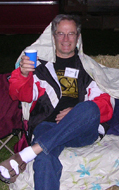 The bottom part of my hand truck is hardly big enough to hold a rock. So I cut a piece of plywood to lay on top with notches to fit around the side braces, and clamp it down with a small c-clamp. It can be stored vertically and secured with a bungee cord.
The bottom part of my hand truck is hardly big enough to hold a rock. So I cut a piece of plywood to lay on top with notches to fit around the side braces, and clamp it down with a small c-clamp. It can be stored vertically and secured with a bungee cord.
I avoid some frustration in my carving by shying away from symmetry. Sometimes it’s hard enough making a shape look right, without having to make the other side look like it, too. * When starting a piece, my assumption is usually that all my surfaces are going to be polished.
When I begin the polishing, I reconsider the time and energy involved. Texture can add to the effect of lights and darks, shine and shadow, and features and form. Plan ahead to save time. Chisel marks, scratches, dimples, rasping, and raw stone surfaces can all find a place in your sculpturing. Sometimes polishing distracts from the presentation with reflections, and drawing the eye into examination of the surface for minor scratches.
I was dealing with steel wool the other day and got a sliver that was reluctant to give up its position. I was able to coax it out with the help of a magnet.
Don’t force your tools: something will give. It may be the tool, or the stone, our some part of your body. Save the blood donations for your local blood bank.
Sometimes I use blue or tan masking tape on my rough stone to identify possible curves and cuts before dust starts flying. Crayons can do the same thing, but don’t have the visibility from a few feet away.
My small maquettes don’t always give me a realistic view of the design’s impact. The cute little shape has its own personality and might not relate favorably to a hundred pound sculpture. Place it near your eyes in front of a distant table to simulate how the sculpture might look on a coffee table. Change the relative viewing distances to suit the scale of your piece.

